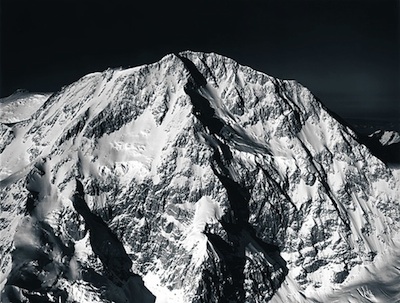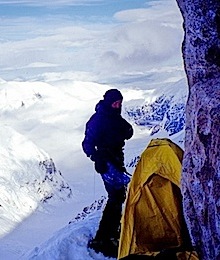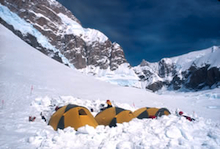Denali Expedition - Cassin Ridge
Overview
The Cassin Ridge (Alaska Grade 5, 5.8, AI 4)

The Cassin Ridge follows the major ridgeline in the center of the photo. Bradford Washburn
Denali offers one of the world's greatest expedition challenges. While it is exceeded in elevation by peaks in South America and Asia, its arctic environment with extreme temperatures and severe storms and its great height above the Alaskan plain make a Denali climb using even the normal West Buttress route a test of personal strength, team work, and logistics. No peak in the world has greater relief: Denali rises 17,000 feet above its surrounding plain, while Everest rises only 13,000 feet above the Tibetan highlands. Vertical elevation gain on Everest from the normal base camp for the South Col route is 11,000 feet; from our landing spot on the Kahiltna Glacier, Denali's summit rises another 13,000 feet. Though lower in total altitude, the sub-arctic cold and high-latitude atmospheric conditions combine to create challenges potentially even more severe than those on 8,000 meter peaks.
The Cassin Ridge has become one of the most sought-after big mountain alpine climbs in the world. There are few routes that follow such a beautiful and continuous line up 9,000 feet of challenging granite, snow, and ice that end right below the highest point in North America.
The Route
We approach the route via the Northeast Fork of the Kahiltna Glacier. After a flight into the Southeast Fork Basecamp, we move up the Lower Kahiltna to the normal Camp 1 used on the standard West Buttress route, then piece together a route up the Northeast fork, continuing past the toe of the West Rib to the base of the Cassin Ridge in the basin at 12,000 feet.
After several days of acclimatization while based at a Bergschrund Camp, we begin the ascent by tackling what many climbers consider the most demanding part of the route, the Japanese Couloir. Twelve full pitches of 60 to 65-degree hard ice with occasional mixed rock climbing lead to the crest of the ridge at 13,400 feet and the first bivouac on the narrow Cassin Ledge.
Just above the Cassin Ledge, the technical crux of the route presents 5.8 mixed climbing up a steep gully. Above this, several pitches of mixed climbing reach the base of a 1,500-foot ice rib, sometimes called "Cowboy Arete", which we ascend in nine pitches of steep, rising traverses on ice and snow. We finish the rib at the toe of a small hanging glacier, and there we are able to establish a comfortable camp in a large crevasse. After a rest day, we climb to the top of the glacier where we are able to bivy deep in a narrow bergschrund at the foot of the first rock band at 14,300 feet.
The first rock band has both mixed and pure rock pitches up to 5.7 in difficulty. We are on very steep ground for 1000 feet; with good protection, comfortable belay stances, and high quality rock, this face climb is very exhilarating. Higher up the terrain eases back to steep snow climbing, and at about 15,800 feet we dig into an exposed snow slope for our camp at the base of the second rock band.
In the second rock band, we encounter more challenging mixed climbing up to 5.7. A short snowfield leads to the third rock band, a 50-degree couloir, and the end of the most difficult part of the route at 17,000 feet. Our exposure to this point has been steadily increasing: to our left and right the ridge drops away abruptly to the cliffs of the Southwest and South Faces. Either way it is about 5,000 feet to the glaciers below.
Above 17,000 feet our climbing takes us over alternating moderate and easy terrain until we eventually reach our final challenge, a 400-foot, 65-degree ice face. Above that we reach the clearly defined summit ridge, which in just fifteen minutes, leads us to our final step of ascent and to the summit of North America.
On our descent via the West Buttress route, we are able to enjoy the scenic west side of the mountain as well as distant views of the Cassin. This route is one of the world's classics; it is very challenging and offers technical and aesthetic rewards from beginning to end.
Denali Expedition - Cassin Ridge
The AAI Approach
As in other parts of the world, AAI expeditions in Alaska are run with small groups of climbers who have carefully prepared for their objective. The Institute takes a team approach to its climbs, and expedition members are expected to take responsibility for themselves and a share of responsibility for the overall operation of the expedition. We do not accept climbers who are only minimally prepared and experienced and who need to be 'hauled' up and down the mountain. Trying to push ill-prepared climbers up the peak is what keeps so many guided and unguided groups from succeeding on Denali.

A climber settling into a bivy site high on the Cassin Ridge.
AAI Collection
The Institute gives its clients careful and detailed counsel in their preparations for climbing objectives, and when appropriate, has them first achieve intermediate goals to fully prepare. Climbs on Denali obviously involve many factors that we cannot control, among them temperature, wind, snowfall, and changeable climbing conditions. The key to success therefore is doing an excellent job working on those areas that a climber can do something about: skill in dealing with cold conditions, skill in climbing at an appropriate technical level, and personal conditioning. To have abilities in these areas well developed and then to combine them with a carefully designed and guided itinerary is the most direct line to safety and success.
AAI expeditions enjoy a rate of safety and success rarely matched by other teams. With well prepared climbers, we do not have to rely on perfect conditions in order to move. Able to remain poised high on the mountain in poor conditions, our teams often make successful summit bids in small windows of good weather when other teams are out of position. AAI doesn't pretend to guarantee good health, good weather, or success on these expeditions, but we are committed to building strong teams and creating high potential for safe and successful climbs. The average individual success rate on Denali is 54% overall and 59% in guided groups other than AAI. The Institute's success rate for individuals for the last nine years is 76% and for expeditions it is 83%.
AAI has the highest level of commitment to environmental protection and restoration, and on all expeditions and instructional programs we teach and follow Leave No Trace ethics and practices for travel, camping, and climbing. The Institute has been a leader in the conscientious use of wilderness environments, including both remote and popular areas of Denali and the Alaska Range. Each year the National Park Service presents "Denali Pro" awards to individuals who have made major contributions to protecting the mountain. Twenty AAI guides and clients have had the honor of receiving this highest Denali National Park and Preserve award since its inception four years ago.

The lower part of the Cassin viewed from our 11,000' camp on the Northeast Fork of the Kahiltna Glacier. John Kear
With regard to expedition processes, we make five to seven camps as we climb alpine style, moving all camps higher as we go and leaving none established above or below. It is not uncommon for temperatures high on the mountain to fall as low as -30F, but at lower elevations daytime temperatures on the glacier can reach as high as 70F, so there we sometimes sleep in the day and ferry loads at night when temperatures are between 0F and 15F. The night's cold improves conditions under foot, and we still have adequate light because of the extreme northern latitude. Double carries are done during the first part of the expedition to ease the work and to help with acclimatization.
All expeditions begin with a meeting and orientation in Anchorage. We spend one night there, then travel by van the next morning to the small town of Talkeetna. There we repack our equipment, meet our ski plane pilots, and as soon as possible, make the beautiful flight to the Kahiltna Glacier at 7300 feet. Soon after our arrival and a review of glacier travel procedures, we begin moving to our first camp.